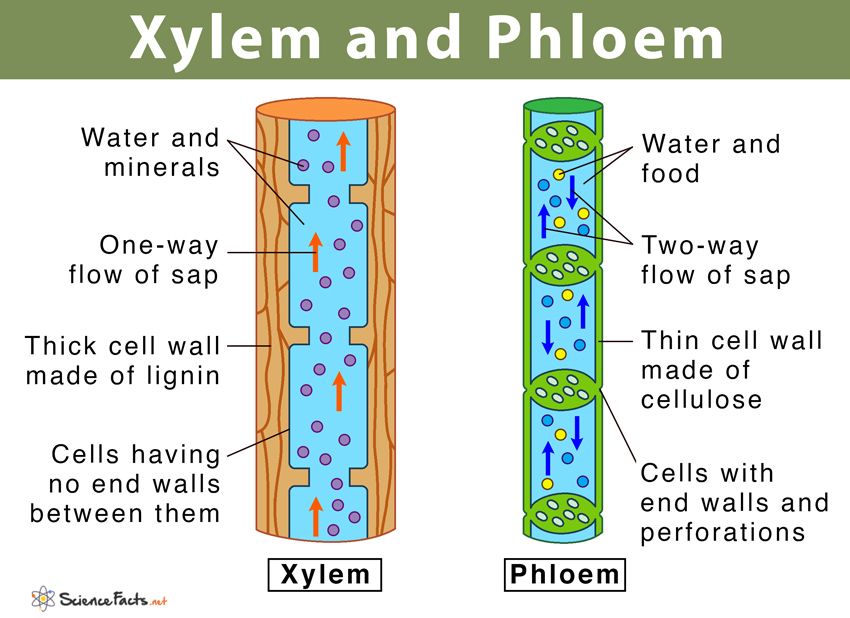Xylem and Phloem
What are Xylem and Phloem
We know all living organisms need food and water for their growth and survival. Have you ever thought about how these nutrients are transported within the body of plants and animals? In animals, this function is performed by the circulatory system. Plants perform a similar function of transporting these nutrients — what we know as sap, by using complex tissues called xylem and phloem.
Xylem is the dead, permanent tissue that carries water and minerals from roots to all other parts of the plant. The term ‘xylem’ is derived from the Greek word ‘xylon’, meaning wood.
Phloem, on the other hand, is the living, permanent tissue that carries food and other organic nutrients from leaves to all other parts of the plant. The word ‘phloem’ is obtained from the Greek word ‘phloios’, meaning ‘bark’.

Together, these two make up the vascular tissues in plants, forming the vascular bundle. Most plants have multiple vascular bundles that form a connection between its different parts, including leaves, stems, and roots.
Xylem vs Phloem: Differences
| Basis | Xylem | Phloem |
|---|---|---|
| Occurrence | Present in roots, stems, and leaves. | Initially present in stems and leaves that later grow in roots, fruits, and seeds |
| Structure | Tubular-shaped with absence of cross walls | Elongated, tubular-shaped with thin-walled sieve tubes connected end to end |
| Location | Found in the center of the vascular bundle | Found in the outer side of the vascular bundle. |
| Composed of | Consists mainly of tracheid and vessel elements | Consists mainly of sieve tubes, sieve cells, phloem parenchyma, fibers, and sclereids |
| Quantity | Constitute the bulk of the vascular bundle | Constitute a small portion of the vascular bundle |
| Nature of Cells | – Made up of dead cells that are hollow from within with no cytoplasm and cell content. Parenchyma is the only living cell – Cell wall is thick and made of lignin – Cells are impermeable to water | – Made up of living cells with little cytoplasm and no nucleus. – Fibers are the only dead cells Cell wall is thin and made of cellulose – Cells are permeable to food |
| Direction of Work | Unidirectional – from roots to the apical parts of the plant through the stem | Bidirectional – both up and down the stem |
| Main Functions | – Transporting water and mineral from the roots to all parts of the plant – Passive transport; does not require energy – Replacing water lost through transpiration and photosynthesis – Providing mechanical strength | – Transporting food from leaves to different parts of the plant – Active transport; requires energy – Transporting proteins and mRNAs throughout the plant – Does not provide mechanical strength |
Similarities
- Both xylem and phloem are complex conducting tissues composed of more than one type of cell.
- Both are components of vascular tissues in plants that serve the purpose of transporting materials throughout the plant.
- Living parenchymatous cells are found in both.
- Dead cells called bast fibers surrounds both tissues.
- Both primary and secondary growth periods are found in xylem and phloem.
- Both develope from procambium that has not been wholly differentiated during primary xylem and primary phloem formation.
Combining the differences and similarities, we can conclude that both xylem and phloem have key features that help to maintain the transport of water, food, and minerals throughout the plant body.
-
References
Article was last reviewed on Friday, February 3, 2023




Thanks for this wonderful answer cause you have helped in my research
I want to know how to know the different
between Xylem and Phloem
Check the table in the post to know the difference